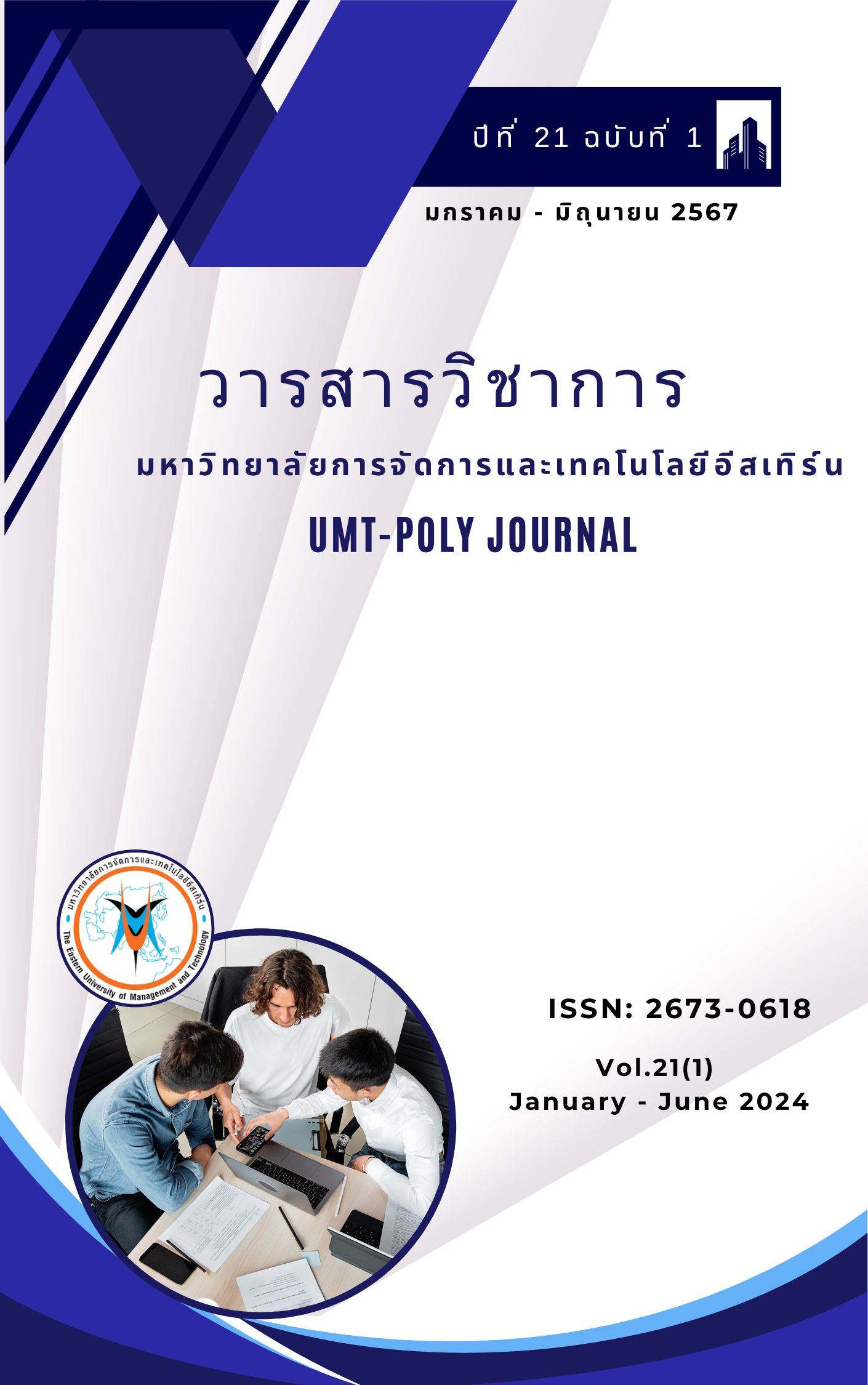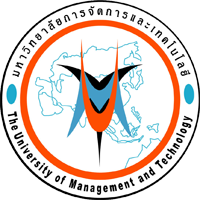วัฒนธรรมองค์กรที่มีผลต่อความสามารถพลวัตและผลประกอบการธุรกิจ
Keywords:
วัฒนธรรมองค์กร, ความสามารถพลวัตร, ผลประกอบการธุรกิจAbstract
งานวิจัยนี้มีวัตถุประสงค์เพื่อศึกษาวัฒนธรรมองค์กรที่มีผลต่อความสามารถพลวัตรและผลประกอบการธุรกิจอย่างไร ด้วยเหตุนี้ ผู้วิจัยได้ใช้แบบสอบถามเพื่อรวบรวมความเห็นของกลุ่มตัวอย่างที่เป็นผู้บริหารองค์กรธุรกิจ จำนวน 420 คน และนำกลับมาวิเคราะห์ผลด้วยสถิติวิเคราะห์ถดถอยพหุคูณแบบ Stepwise
ผลวิจัยพบว่า องค์ประกอบของวัฒนธรรมองค์กร เช่น วัฒนธรรมแบบเปลี่ยนแปลง วัฒนธรรมการตลาด และวัฒนธรรมเครือญาติ มีอิทธิพลร่วมกันอย่างมีนัยสำคัญต่อความสามารถพลวัตที่สัมประสิทธิ์สหสัมพันธ์ร่วมกันที่ R2 = .76 ความคลาดเคลื่อนสะสมร้อยละ 37 กับมีความสามารถอธิบายความแปรปรวนร่วมกันได้ที่ค่า F เท่ากับ 455.01 (Sig. 000) ขณะที่ผลทดสอบความเป็นอิสระของค่าคลาดคลื่อนตัวแปรเหตุตามค่า Durbin-Watson ที่ 1.51 นอกจากนี้ ผลวิจัยยังพบว่า วัฒนธรรมตลาดมีอิทธิพลโดยตรงต่อผลประกอบธุรกิจร้อยละ 62 รวมถึงความสามารถพลวัตรมีอิทธิพลทางตรงต่อผลประกอบการธุรกิจอีกร้อยละ 69 กับมีสัมประสิทธิ์สหสัมพันธ์ที่ค่า R2 เท่ากับ .47 กับ .53 ตามลำดับ ดังนั้น การพัฒนาวัฒนธรรมการตลาดสามารถสร้างความสามารถพลวัตรและผลประกอบการธุรกิจ
Downloads
References
กัญญสิริ จันทร์เจริญ. (2554). บทที่ 5 การกำหนดประชากรและกลุ่มตัวอย่าง, สืบค้นจาก
https://www.ict.up.ac.th/surinthips/ResearchMethodology_2554.
ประสพชัย พสุนนท์. (2557). การกำหนดขนาดตัวอย่างตามแนวทาง Krejcie and Morgan (1970) ในการวิจัยเชิงปริมาณ. วารสารวิชาการศิลปศาสตร์ประยุกต์, 7(2), 112 – 120.
ไพโรจน์ ปิยะวงศ์วัฒนา (2016). การเรียนรู้ขององค์กรและความสามารถเชิงพลวตัที่มีอิทธิพลต่อผลการดำเนินงาน. WMS Journal of Management Walailak University. 5(3), 22-34.
วีระศักดิ์ จินารัตน์. (2564). ระเบียบวิธีวิจัยสมัยใหม่, พิมพ์ครั้งที่ 1; อุบลราชธานี, ยงสวัสดิ์อินเตอร์กรุ๊ป จำกัด.
Altinay, L., Madanoglu, M., De Vita, G., Arasli, H., & Ekinci, Y. (2016). The interface between organizational learning capability, entrepreneurial orientation, and SME growth. Journal of Small Business Management, 54(3), 871-891.
Anand, G., Ward, P., Tatikonda, M., Schilling. D.. (2009). Dynamic capabilities through continuous improvement infrastructure. J. Oper. Manag. 27 (6). 444-461.
Barney, J., Wright, M., & Ketchen, D.J., (2001). The resource-based view of the firm: ten years after 1991. J. Monag. 27 (6), 625-641.
Bawany, S. (2016). Leading change in today's VUCA world. Leadership Excellence Essentials 33(2), 31-32.
Bayu, F., Berhan, E., & Ebinger, F.A (2022). System Dynamics Model for Dynamic Capability Driven Sustainability Management. J. Open Innov. Technol. Mark. Complex. 2022, 8, 56.
Branca, T.A., Formal, B., Colla. V., Murri, M.M., Streppa, E., & Schröder, A.J., (2020). The challenge of digitalization in the steel sector. Metals 10 (2), 288.
Cameron and Quinn's. (1999). Corporate culture. environmental innovation and financial performance. 18(1), 1369-1375.
Clauss, T., Breier, M., Kraus, S., Durst, S., & Mahto, R.V., (2022). Temporary business model innovation-SMEs' innovation response to the Covid-19 crisis. R&D Manag. 52(2).
-312.
Hitt, M.A., Ireland, R.D., Camp, S.M. & Sexton, D.L. (2001). Strategic entrepreneurship. Entrepreneurial strategies for wealth creation. Strategic Management Journal, Vol. 22 Nos 6/7, pp. 479-491.
Hogan, S.J. & Coote, L.V. (2014). Organizational culture, innovation, and performance: A test of schein's model. J. Bus. Res. 2014, 67, 1609-1621.
Li, L., Tong. Y., Wei, L. & Yang, S., (2022). Digital technology-enabled dynamic capabilities and their impacts on firm performance: evidence from the COVID-19 pandemic. Inf Manag. 59 (8), 103689.
Marsick, V.J. & Watkins, K.E. (2003), "Demonstrating the value of an organization's learning culture: the dimensions of the learning organization questionnaire", Advances in Developing Human Resources, 5(2), 132-151.
Miller, D. (1983). The Correlates of Entrepreneurship in Three Types of Firms. Management Science. 29(7), 770-791.
Miller, D., & Friesen, P. H. (1983). Strategy‐making and environment: the third link. Strategic management journal, 4(3), 221-235.
Mustafa, M.B., Saleem, I., & Dost, M.A. (2022). Strategic entrepreneurship framework
for an emerging economy: reconciling dynamic capabilities and entrepreneurial orientation. Journal of Entrepreneurship in Emerging Economies. 14(6), 1244-1264
Ricciardi, F., Zardini, A. & Rossignoli, C. (2016). Organizational dynamism and adaptive business model innovation: the triple paradox configuration. Journal of Business Research, 69(11), 5487-5493.
Saputra, N., Sasanti, N., Alamsjah, F. & Sadelia, F. (2021). Sixth Information Systems International Conference (ISICO 2021) Strategic role of digital capability on business agility during COVID-19 era. 1877-05092021 The Authors. Published by Elsevier B.V. This is an open access article under the CC BY-NC-ND license (https://creativecommons.org/licenses/by-nc-nd/4.0) Peer-review under responsibility of the scientific committee of the Sixth Information Systems International Conference. 10.1016/j.procs.2021.12.147.
Teece, D. J. (2012). Dynamic Capabilities: Routines versus Entrepreneurial Action. Journal of Management Studies, 49(8): 1395-1401.
Teece, D., Pisano, G., & Shuen, A., (1997). Dynamic capabilities and strategic management. Strat. Manag. J. 18(7), 509-533.
van de Wetering, R., 2021. Understanding the impact of enterprise architecture driven dynamic capabilities on agility: a variance and fsQCA study. Pac. Asia J. Assoc. Inf. Syst. 13 (4), 2.
Wang, C.L., Senaratne, C., Rafiq, M. (2015). Success traps, dynamic capabilities and firm performance. Br J Manag 26(1). 26-44.
Yeow, A., Soh, C. & Hansen, R. (2018). Aligning with new digital strategy: A dynamic capabilities approach. J. Strateg. Inf. Syst. 2018, 27, 43-58.
Downloads
Published
Issue
Section
License
ประกาศลิขสิทธิ์
เนื้อหาและข้อมูลในบทความที่ลงตีพิมพ์ในวารสารวิชาการมหาวิทยาลัยการจัดการและเทคโนโลยีอีสเทิร์น ถือเป็นข้อคิดเห็นและความรับผิดชอบของผู้เขียนบทความโดยตรง ซึ่งกองบรรณาธิการวารสารไม่จำเป็นต้องเห็นด้วยหรือร่วมรับผิดชอบใด ๆ
บทความ ข้อมูล เนื้อหาหรือรูปภาพ ฯลฯ ที่ได้รับการตีพิมพ์ในวารสารวิชาการมหาวิทยาลัยการจัดการและเทคโนโลยีอีสเทิร์น ถือเป็นลิขสิทธิ์ของวารสารวิชาการมหาวิทยาลัยการจัดการและเทคโนโลยีอีสเทิร์น หากบุคคลหรือหน่วยงานใดต้องการนำข้อมูลทั้งหมดหรือบางส่วนไปเผยแพร่ต่อหรือเพื่อกระทำการใด ๆ จะต้องได้รับอนุญาตเป็นลายลักษณ์อักษรจากวารสารวิชาการมหาวิทยาลัยการจัดการและเทคโนโลยีอีสเทิร์นก่อนเท่านั้น




